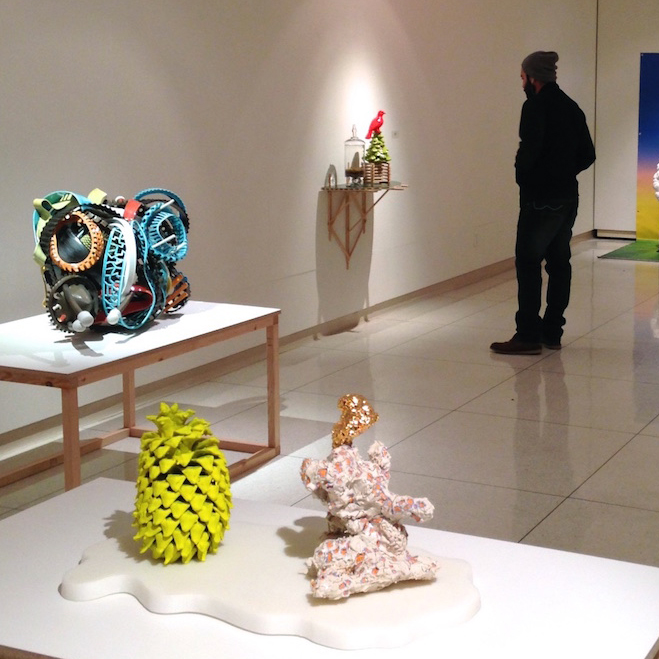There is an aesthetic on the rise in contemporary ceramic sculpture, particularly among the emerging artists, that focuses on play over specifically ceramic phenomena. It is a sensibility inspired by Ron Nagle whose tiny ceramic sculptures have become massively successful, but it walks away from his elegance and small scale. The artists featured in Constructed, at the Nightingale Gallery of Eastern Oregon University (Le Grande, February 6-27, 2015), all work in this eclectic realm and were plucked from around the U.S. by curator Peter C. Johnson.
The work is connected by an elemental curiosity in gravity, color, material, and relationships. It is skeptical of all things we have accepted as true and attempts to disprove them, mixes real and unreal, abstract and figurative, tearing down our reality bit-by-bit, leaving us insecure, but with a freshness that borders on naivety. It is deliberately playful-seeming with a wry edge of humor. I say “seeming” because the craft process, just like that of Nagle, can be extraordinarily taxing and requires immense skill. Constructed makes you smile before you think, refreshing in the often painfully serious world of art and particularly in the ceramic medium, where given its past history, artists bend over backwards to make sure that you know that their mud is ART.

Chad Curtis, Dis•location, glazed ceramic, earth, wood, moss, glass, Constructed exhibition at The Nightingale Gallery of Eastern Oregon University
“Clay has long been valued for its versatility,” Johnson writes. “It can be immediate and primal or industrial and rigid in its appearance. It has the ability to be masked and disguised or exposed as the primordial material it is. This exhibition demonstrates this versatility and presents the work of eleven artists whose methods of construction underscore the varied properties of clay to imbue the work with meaning.”
Much of the work in the exhibition is not seen immediately as ceramic and in some cases it actually tries hard not to be, making its sources ambiguous. Andrew Casto’s Assemblage 65 is covered in an amazing pink rubber and Chad Curtis only uses a couple ceramic elements in Dis•location, which includes wood, glass, paint, and moss.
The art was fiercely independent, space-hungry and competitive, desperately wanting to escape the table and own its space. There were a few pieces, by David Katz, Chad Curtis, Linda Lopez, and Zimra Beiner, that avoided this installation trap with their spatial self-containment.

Andy Casto, Assemblage 65, ceramic, rubber, plastic, osb hardware, Constructed exhibition at The Nightingale Gallery of Eastern Oregon University
In his catalog essay, Johnson explains his curating strategy based on artists’ material experimentation.
“All of these artists are linked by their thoughtful engagement of process and material. In each, case the construction method emphasizes an attribute of the clay, which is central in supporting and expanding the artist’s conceit behind their work.”
Constructed is presented as a ceramic exhibition for ceramic artists. It is in-house but guests are welcome, successfully visualizing the encyclopedia of reasons why we love the material— its seductive surfaces, versatility, direct hand-to-object immediacy, etc. In one sense, it is a great celebration, but it also comes perilously close to an exhibition better left, once a year, to the hermetic shows surrounding NCECA. Declaring it “a ceramic show” was unnecessary, alienated it and limited its penetration into the art world at large. The same exhibition could have been presented more progressively as a showcase of exciting trends in sculpture, which it accomplished with some but perhaps accidental success.
Justin Crowe is a Writer-at-Large for CFile.
Any thoughts about this post? Share yours in the comment box below.

Linda Lopez, Doing Nothing, ceramic and wood, Constructed exhibition at The Nightingale Gallery of Eastern Oregon University

Contructed exhibition at The Nightingale Gallery of Eastern Oregon University, Curated by Peter C. Johnson

Matt Ziemke, untitled, glazed ceramic, aluminum leaf, enamel, Constructed exhibition at The Nightingale Gallery of Eastern Oregon University

Zimra Beiner, Bookend, glazed stoneware, books, wet clay, Constructed exhibition at The Nightingale Gallery of Eastern Oregon University

Lauren Gallaspy, Into the Brain like Branches, porcelain, glaze, underglaze, gouache, varnish, Constructed exhibition at The Nightingale Gallery of Eastern Oregon University

Ryan LaBar, Varieties of Uncertainty, Constructed exhibition at The Nightingale Gallery of Eastern Oregon University

Chris Dufala, Withering, earthenware, underglaze, glaze, stain, Constructed exhibition at The Nightingale Gallery of Eastern Oregon University

Mathew McConnell, What It Means to Move, earthenware with bone charcoal and graphite, Constructed exhibition at The Nightingale Gallery of Eastern Oregon University




Add your valued opinion to this post.